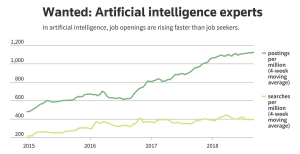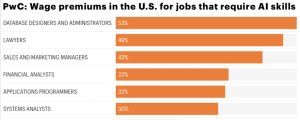It may surprise some people to learn that artificial intelligence isn’t a new technology.
The term itself dates back to the 1950s, and AI-powered tools have been steadily making their way into websites, computer systems and even our homes (predictive texting/emailing anyone?)
Of course, what is new about AI was the public release of the ChatGPT in late 2022 (yes, it really is only less than two years ago). The future really is here.
Today, ChatGPT is the fastest-growing consumer app in history, and now logs 100 million active users each week. More than 90% of Fortune 500 companies use the app. GenAI platforms are becoming bigger and more powerful — and even more AI tools are on the way.
But, in parallel with the growth of AI is also the demand for people with AI skills.
As GenAI accelerates technological change on a massive scale (and at record speeds), it’s accelerating the challenges businesses need to make, and that means searching high and low for talent to keep pace in this increasingly AI-powered world.
AI talent is scarce

Source: https://medium.datadriveninvestor.com/good-news-for-job-seekers-with-ai-skills-there-is-a-shortage-of-talent-e127ae4fcb35

New data from a recent survey of HR professionals around the world reveals just what talent leaders are up against.
While there is enormous demand for AI (with nearly all companies surveyed are using AI in their processes or products), the fact is that nearly 70% of HR leaders say it’s much more challenging to hire people with adequate AI skills than it is to find people for traditionally hard-to-hire roles in data science and software engineering.
A whopping 95% said they’re needing to add AI skills to job requirements for roles that aren’t even focused on AI.
Because talent is scarce, it’s also coming at a cost.
More than half of companies surveyed say they spend at least $10,000 to fill AI roles.
A handful of companies are spending $50,000 or more to recruit for these in-demand roles.
More than 90% of HR leaders at companies using AI say job candidates are asking for higher salaries — and two-thirds of the time companies are agreeing to these salary demands.
How to find AI-skilled people now
There are undeniable benefits to having an AI-enabled workforce that can adapt and contribute to today’s tech-driven environment.
But today, many companies’ approach to AI resembles their response to earlier technological revolutions: starting with tools instead of people.
So, as they jump to invest in new technologies, businesses risk leaving behind a much more important asset: their workforce, including the non-technical employees (like HR teams and marketers) who will need AI skills as much as their more tech-savvy colleagues.
To compete in an AI-driven world of work, businesses will need to think differently about how they equip both their incumbent workforce – and their new hires – with the skills to navigate this changing landscape.
Here are four things companies can do to build diverse and scalable AI talent pipelines:
Start now
The demand for AI and other emerging skills will only accelerate, so companies should move quickly to understand and embrace AI to gain an advantage over it.
HR and company leaders must pinpoint the roles, headcount and skills profiles their first will need to succeed.
By building this foundation now, forward-looking companies can optimize their recruiting and hiring efforts.
Focus on real business problems
There isn’t the time to create an innovation lab on a remote outpost of the company campus and hope that something incredible happens.
Companies should upskill existing employees and bring in outside expertise to solve a meaningful business problem.
The goal should be to tear down any silos that exist and ensure that the AI talent you’re creating and hiring understands how your business works.
Just as AI has been embedded into many facets of modern life, AI should be integrated into the daily operations and core components of your business.
Don’t sleep on existing talent
It’s time to rethink the “build versus buy” paradigm for developing new AI talent.
The best tech talent might already be working for your organization.
Many companies can address talent shortages by up-skilling and re-skilling their existing employees, which is something that workers want.
More than 60% of workers think AI will affect their careers positively, and two-thirds of workers expect their employers to teach them how to use this technology.
Companies should identify employees with critical durable skills and help them master technical and AI skills.
They should also identify positions where tech talent is most needed and ensure that employees gain new or additional skills so they can move into these roles.
Fill skill gaps by recruiting non-traditional talent
Companies should consider sourcing talent from non-traditional sources rather than chase a limited supply of highly skilled job candidates.
A growing number of businesses and state governments are adopting skills-based hiring practices that recognize not college credentials and job histories, but knowledge and competencies.
This approach lets them tap into a talent pool of more than 70 million American adults who have acquired skills from prior jobs, short-term training programs, the military and other non-traditional avenues.
Colleges, universities and workforce development organizations will continue to supply tech and AI talent to business.
But other models, such as tech industry apprenticeships and hire-train-deploy programs, have been complementing traditional recruiting by building pathways that produce talent for in-demand roles and addressing the gap between traditional academia and actual on-the-job skills required by employers.
Final thoughts
It’s worth remembering that organizations around the globe are all trying their best to navigate this new AI-powered world.
In the short term, many companies are pouring money into recruiting budgets and payrolls to win the competition for available talent.
But future-forward companies who want long-term wins are realizing that they’ll have to help themselves.
Investing in their current workforce, and recognizing the potential of previously untapped talent pools, will be keys to success for any business hoping to keep pace in tomorrow’s AI-driven world of work.
